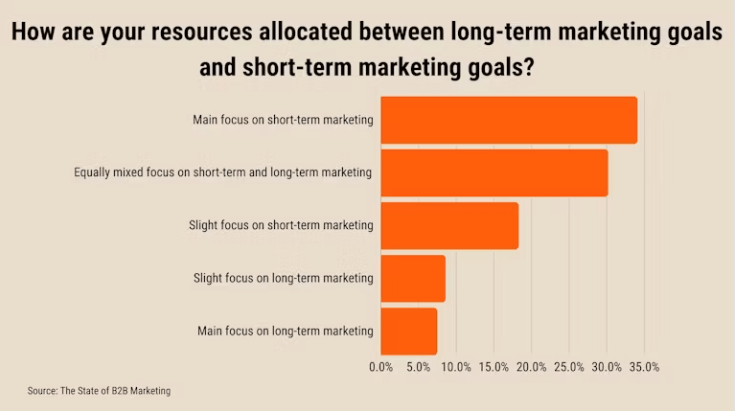B2B audiences are human audiences. Humans that don’t follow predictable paths to purchase, don’t hang out solely in B2B environments and rarely make decisions based on rational factors alone. Launching a successful marketing campaign requires more than just reaching the right job titles with product messaging. It demands a strategic approach that considers varying audience motivations, focuses on building lasting value and achieves an emotional connection for your brand.
Often, the initial instinct is to laser-focus on those who appear ready to buy now. However, talking only to that very small pool of prospects is costly, resource-heavy and above all else, a slippery slope to falling into the dreaded ‘doom loop’.
There is, of course, a time and a place for this type of laser-focus. It’s smart strategic thinking to have a highly targeted, performance element to your campaign. However, it must only ever be that – a part of your campaign. Put too much focus into this at the expense of tactics that drive emotional connection and build longer-term memory structures with your audience, and you will become over-reliant upon the short-term outcomes of marketing. These short-term outcomes are much less dependent upon forces upon which you can exert any control, such as changes in competitor product/positioning, category shifts in demand, as well as advertising factors such as media inflation and competitor ad spend.
So to avoid this, we must ask ourselves, do we have the right balance in our campaign between tactics that will deliver short-term outcomes and those that will provide longer-lasting impact? Are our marketing efforts genuinely contributing to sustainable brand growth?

Short-termism is rife in B2B marketing
To do that, just for a moment we need to stop thinking like a brand with something to sell, avoid the allure of the immediacy of marketing metrics (there are more ways to justify investment to the CFO over and above leads) and instead think like the customer. Too often, marketers skip that crucial first step of market orientation – seeing the situation through the lens of the person buying your brand. This leads to reduced effectiveness in positioning and targeting, ultimately leading to poorer outcomes.
However, it is important we layer a degree of pragmatism to all of the above in order for it to be useful and applicable. Here is a step-by-step process of some of the most crucial factors to consider when planning a B2B marketing campaign:
1. Understand the entire buying ecosystem
Forget the singular ‘decision-maker’. In B2B, purchasing decisions are rarely made in isolation. Identify all the stakeholders involved – from the initial researchers and influencers through to the budget approvers and end-users. Your campaign needs to resonate with each of these roles, addressing their specific needs and concerns, even if their initial engagement isn’t a click or a lead form submission. Remember, some of the most influential voices in the decision-making process may never proactively search for your brand or download some content, but they’ll still need to be aware of you. People don’t buy brands they’ve never heard of.
2. Prioritise awareness and mental availability
The basic principles we learnt from Byron Sharp in his seminal publication, How Brands Grow, are as readily applicable and relevant in B2B as they are for B2C (remember, we’re talking to humans, not job titles). Not everyone who will influence a purchase is actively looking for a solution right now, in fact the vast majority of them aren’t. However, when they do enter the market they do so with a select number of brands in mind, and it’s key that you are one of them. Your campaign should aim to build brand awareness and as a result, mental availability across the wider target audience.
3. Get the balance of targeting right
Marketers often rush to hyper-target. Unfortunately it’s a tactic too often over-relied upon and over-invested into. It’s a safe space for marketers to justify spend to non-marketing stakeholders internally, but it’s an effectiveness & efficiency trap if it’s running in isolation. Ensure that your campaign is broad enough to reach the wider stakeholder ecosystem, and secondly goes beyond those who already know you and are familiar with you. Growth comes from reaching new buyers, not only focusing on existing audiences.

Success doesn’t come from targeting the ‘bullseye’ audience alone
4. Diversify your content formats and channels
Not all stakeholders engage with content in the same way. A successful campaign utilises a diverse range of formats – from insightful blog posts and whitepapers to engaging webinars and thought-leadership social content. Your audience will show up in a multitude of unexpected ways, so it’s crucial to have multiple content types and touchpoints ready for when the point of action arrives.
Additionally, this isn’t just a point to maximise physical availability. Campaign effectiveness increases with each channel/touchpoint added. The more times your audience experiences your brand in different ways, means greater brand recall, understanding and favourability.
5. Focus on value and education
B2B buyers are seeking solutions to their challenges, often without knowledge of what that solution exactly is. Your campaign should prioritise providing genuine value through educational content that addresses their pain points, offers actionable insights, and positions your company as a thought leader in the industry. This builds trust and credibility, which are crucial for long-term relationships. It’s not enough to shout the loudest as to why you’re the best brand in a category, you need to back it up with content that reinforces your authority and firmly positions you as the leading voice in the industry. In practice, this means balancing being self-promotional with a more nuanced approach to communications. Are you truly showcasing your expertise? Is the target buyer leaving their brief experience with your marketing collateral with more than they went into it with?
6. Have a measurement framework and stick to it
While immediate conversions offer a tempting snapshot of campaign performance, a truly successful B2B marketing strategy demands a more holistic view. Before launching any campaign, define clear & measurable objectives aligned with your overall business goals. Identify the KPIs that will indicate progress at each stage of the buyer’s journey (and avoid falling into the trap of these becoming vanity advertising or media metrics). Additionally, don’t try to connect every piece of activity directly to a conversion-based metric or a commercial outcome. All elements of a campaign need to be working alongside each other to perform effectively – judge them appropriately based on their role in the campaign strategy.
Critically, establish a consistent framework for tracking these metrics, along with targets. Regularly monitor your performance against these KPIs, analyse the data to identify what’s working and what isn’t, and be prepared to make adjustments to your strategy.
Results that deliver commercial outcomes, that are truly incremental, take time and commitment to achieve. A measurement framework with clear targets sets expectations and reduces the likelihood of knee-jerk or subjective decision making.
7. Embrace a test-and-learn approach
The B2B marketing landscape is constantly evolving. Don’t be afraid to experiment with different messaging, content formats, and channels. Continuously analyse your results, learn from what works and what doesn’t, and adapt your approach accordingly. One of the input sources to proper effectiveness measurement is testing – triangulating different data sources is key.
So, as you plan your next B2B marketing campaign, remember that true success lies in cultivating a wider ecosystem of awareness and building genuine connections with the humans behind the job titles. By understanding their diverse needs, offering real value, and consistently showing up in relevant ways, you’ll not only capture their attention when they’re ready to buy but, more importantly, you’ll become a brand they already know and trust.
The post How to plan a successful B2B marketing campaign appeared first on Hallam.
hallam.agency (Article Sourced Website)
#plan #successful #B2B #marketing #campaign
